Comparing Osteichthyes and Chondrichthyes criteria and rubric
Bony fish
-

Figure 1: Representatives of Class Osteichthyes Salmonoids, tuna, sunfish, eels, groupers, etc.
- Appeared ~420 million years ago
- The largest class of vertebrates with ~28,000 species (96% of all fishes)
Evolutionary advancement
Bony skeleton
- Stronger and more rigid than cartilage.
- Made of collagen and calcium.
- The operculum (bony plate that protects the gills). Typically, gill slits cannot be seen.
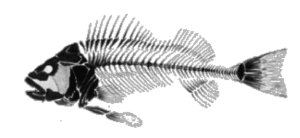
General anatomy
- Have a jaw and skeleton of bone with operculum
- Paired fins
- Homocercal tail (symmetrical)
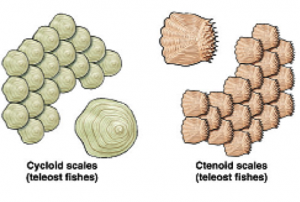
Figure 3: Dermal scales - Swim bladder
Integument: Mucus glands embedded in dermal scales
- Formed from the deeper skin layer
Swim bladder
- Large air sac within the fish
- Acts as a buoyancy organ – it helps the fish maintain buoyancy in the water (so it doesn’t sink to the bottom)
- Increases in size when the fish wants to go up and decreases in size when the fish wants to go down.
- Neutrally buoyant fishes can hover in the water and swim with much less energy. However, there is only one depth at which a fish has neutral buoyancy, so it is important for the fish to be able to regulate the amount of gas in the swim bladder to maintain neutral buoyancy at different depths.” (Liem 1998:17)
- This allows for easier neutral buoyance – more energy efficient (bony fish don’t need to swim to stay in the water column).

Physiology
Digestive system
- Similar to chondrichthyes, however no enlarged liver.
- Have a U-shaped stomach

Figure 5: Bony fish digestive system - Have pyloric ceca which increases gut area and aids in digestion by secreting digestive enzymes.
- No true cloaca (Separate opening for digestive system)
Bony fish digestion resource [website]
Reproduction
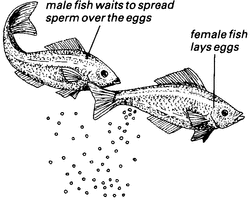
- External and internal fertilization (depends on species)
- Ovoparous (egg laying), Viviparous (live bearing), ovoviviparous (Aplacental yolk sac viviparous) all seen in bony fish.
- Some are hermaphrodites (both male and female reproductive organs at same time, or can change)
Fun fact: Seahorses (Family Syngnathidae) are ovoviviparous (nutrients from yolk sac inside a parent) but it is the male seahorse that holds the eggs.
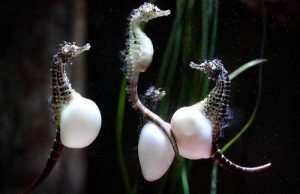
- The female seahorse deposits eggs into a pouch on the male.
- The male releases sperm into the pouch, fertilizing the eggs.
- After the embryos have developed, the male gives birth to tiny seahorses.
Subclasses of Osteichthyes
Subclass Actinopterygii
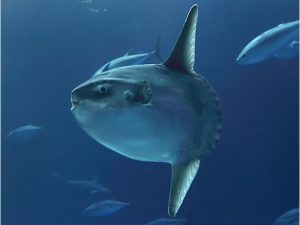
- Ray-finned fishes
- Fins are webs of skin supported by bony spines or “rays”
- 99% of all bony fish species
- Salmon, eels, angler fish, seahorses, cod, halibut
Subclass Sarcopterygii
- Lobe-finned fishes
- Fins are fleshy and joined to the body by a bone (able to support weight)

Figure 9: Lungfush (Subclass Sarcopterygii) - Limbed animals are thought to have evolved from lobe-finned fishes
- Only 7 species are living today
- Coelacanth -> thought extinct, rediscovered in 1938
- Lungfish -> Have lungs and gills
Question: Of the six species of lungfish, only one can respire with their gills (Australian lungfish). This lungfish only have one lung, while the other 5 species have two lungs, but cannot use their gills to respire. What does this tell you about the process of evolution?

Osteichthyan spotlight
Deep-sea angler fish (Family Ceratiidae)
- Have a bioluminescent lure protruding from their head to attract prey.
- Show extreme sexual dimorphism – Difference in size/appearance between the sexes. Males are ~40x smaller.
- Since finding mates can be hard in the deep sea, females release pheromones, which attract males.
- When a male finds a female – they bite onto the female, digest part of their own face to become permanently attached.
- As time goes on, the male loses organ systems and even their brain, and basically become a growth on the female.
- But, the gonads continue producing sperm and give females a constant supply of sperm for reproduction in a challenging environment!
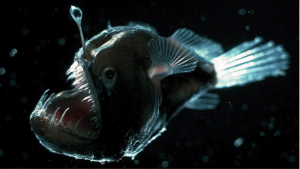
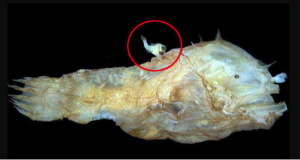
Extra questions:
1. Compare and contrast the three classes of fishes.
2. What do you think is the next logical step in evolution for Subclass Sarcopterygii? Justify your answer.
3. Explain how bony fish maintain and control their buoyancy. How does this differ from cartilaginous fish (class Chondrichthyes)?
4. What are the three characteristics shared by all fish?
5. Compare fins in subclass Actinopterygii to Sarcopterygii.
6. What does it mean to be hermaphroditic? Can you find an example of a bony fish that is a hermaphrodite?
7. Outline the difference between homocercal and heterocercal caudal fins.
Comments by shaun pletsch